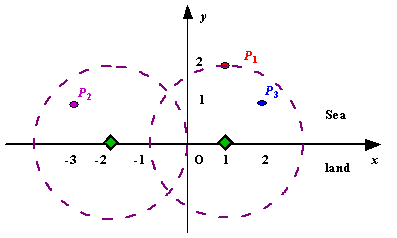POJ 1328 Radar Installation(貪心)
阿新 • • 發佈:2019-02-11
Description
Assume the coasting is an infinite straight line. Land is in one side of coasting, sea in the other. Each small island is a point locating in the sea side. And any radar installation, locating on the coasting, can only cover d distance, so an island in the sea can be covered by a radius installation, if the distance between them is at most d.We use Cartesian coordinate system, defining the coasting is the x-axis. The sea side is above x-axis, and the land side below. Given the position of each island in the sea, and given the distance of the coverage of the radar installation, your task is to write a program to find the minimal number of radar installations to cover all the islands. Note that the position of an island is represented by its x-y coordinates.

Figure A Sample Input of Radar Installations
Input
The input consists of several test cases. The first line of each case contains two integers n (1<=n<=1000) and d, where n is the number of islands in the sea and d is the distance of coverage of the radar installation. This is followed by n lines each containing two integers representing the coordinate of the position of each island. Then a blank line follows to separate the cases.The input is terminated by a line containing pair of zeros
Output
Sample Input
3 2 1 2 -3 1 2 1 1 2 0 2 0 0
Sample Output
Case 1: 2 Case 2: 1
Source
這道題就是一道貪心題,思路並不難,但是悲催的是WA了5次,居然是因為如果不符合條件時輸出-1時直接輸出了-1,前面沒帶Case。。。。sad。。。害得我把點的排序按點排了一次,又按區間左端點排了一次。。不過事後發現這兩種排序都可以。。 本題貪心思路是把點轉化為在x軸座標上的區間(即能保證覆蓋該小島的雷達所有可能位置的集合),然後按點的順序排也行,按左端點排也行。然後最左邊的依次向右遍歷,如果下一個區間的最左端在上一個雷達的右端,顯然需要放一個新雷達;如果在左端的話,則需要判斷最右端了,如果最右端也在上個雷達左端的話,那麼這個雷達顯然不能覆蓋當前這個小島,需要把雷達位置調整為當前區間的最右端,這樣既能覆蓋之前的也能覆蓋現在的;如果最右端在上個雷達右端,則無需調整也無需放置新雷達。#include <stdio.h> #include <stdlib.h> #include <string.h> #include <math.h> #include <algorithm> using namespace std; struct node { double zuo, you; } fei[2100], t; int cmp(node a, node b) { return a.zuo < b.zuo; } int x[2100],y[2100]; int main() { int i, j, n, d, num, flag, s=0; double z, p; while(scanf("%d%d",&n,&d)!=EOF) { if(n==0&&d==0) break; s++; flag=0; for(i=0; i<n; i++) { scanf("%d%d",&x[i],&y[i]); if(y[i]>d) flag=1; } if(flag) printf("Case %d: -1\n",s); else { for(i=0; i<n; i++) { z=sqrt(d*d*1.0-y[i]*y[i]*1.0); fei[i].zuo=(double)x[i]-z; fei[i].you=(double)x[i]+z; } sort(fei,fei+n,cmp); num=0; p=-100000000; for(i=0; i<n; i++) { if(fei[i].zuo>p) { num++; p=fei[i].you; } else if(fei[i].you<p) { p=fei[i].you; } } printf("Case %d: %d\n",s,num); } } return 0; }
